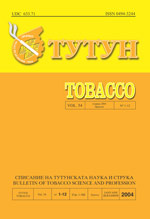
|
 pdfs/vol 60 1-6 6..pdf
pdfs/vol 60 1-6 6..pdf
THE USE OF GLYPHOSATE (N-(PHOSPHONOMETHYL)
GLYCINE) IN SUCKER CONTROL OF TOBACCO
Hristo Bozukov
Tobacco and Tobacco Products
Institute-Plovdiv4108 Markovo, Bulgaria
e-mail: h_bozukov@abv.bg
ABSTRACT
Topping of tobacco (cutting off the floral
buds) is cultural practice which guarantees a high
economic effect reflected in increased yield and quality.
In normal conditions of growing, the topping is
accompanied by vigorous formation of suckers. Removal of
floral buds and suckers can be performed
in two ways: mechanically (by hand or with specialized
technique) and chemical (with application
of physiologically active substances - FAS). According to
the type of their effect on suckers, FAS
are divided in those with contact activity and those with
systemic activity. So far, from the products
with systemic activity the salts (potassium or hallein)
of the maleic hydrazide (MH) have been
used. After the deadline for its use in Bulgaria has expired,
there are no new systemic products to
substitute it. The aim
of investigation was to study the
possibilities for application of the herbicide
Glyphosate not only for chemical
topping of tobacco plants but also for control of suckers
appearing after topping, with high
technical and economical effectiveness among parasitic
formations, free of phytotoxic effect
on the crop.
Key words:
tobacco, topping, sucker formation, sucker
control, active substances
|
|



